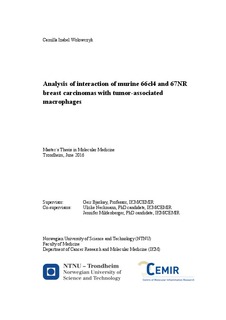| dc.description.abstract | Breast cancer is the most common cancer among women in the world, and death is usually caused by metastasis. A tumor is a heterogeneous mass of different cells, and the tumor microenvironment is complex with extensive communication between the different cell types. Tumor cells are able to polarize cells of the microenvironment, like macrophages, by secreting different compounds including members of the TGF-β superfamily. Macrophages can be polarized towards classically activated M1 macrophages or alternatively activated M2 macrophages. Tumor-associated macrophages (TAMs) are mainly M2 macrophages and support tumor growth by promoting tumor cell survival and proliferation, matrix remodeling, angiogenesis and metastasis. The number of macrophages in a tumor is correlated with poor prognosis in breast cancer patients. By utilizing the 4T1 breast cancer mouse model the communication between tumor cells and macrophages was studied. Transcriptome data of cell lines and primary tumors of the non-metastatic 67NR and the metastasizing 66cl4 showed a higher amount of M2 macrophage markers in 66cl4 primary tumors. 66cl4 cells also produce and secrete the TGF-β superfamily member BMP4, as well as its antagonist GREM1. GREM1 was produced even more in 168FARN cell lines, as well as found to be cell surface-associated. High amount of GREM1 is correlated to poor prognosis in breast cancer patients. By adding conditioned medium from the tumor cells to RAW 264.7 macrophages, it was seen that conditioned medium from 168FARN, 66cl4 and 4T1 potently inhibited both basal and rmBMP4-stimulated SMAD signaling. Conditioned medium from 66cl4 also upregulated the inflammatory signaling in RAW 264.7 macrophages by activating STAT1. In bone marrow-derived macrophages (BMDMs) it was seen that both conditioned medium from 67NR, 168FARN and 66cl4, as well as the presence of them in a transwell changed the morphology of the BMDMs. The presence of 67NR, 168FARN and 66cl4 cells also activated the SMAD pathway of the BMDMs. Further research is however needed to see if the regulation of the SMAD pathway in macrophages is related to the different functions of macrophages in tumors. | nb_NO |
